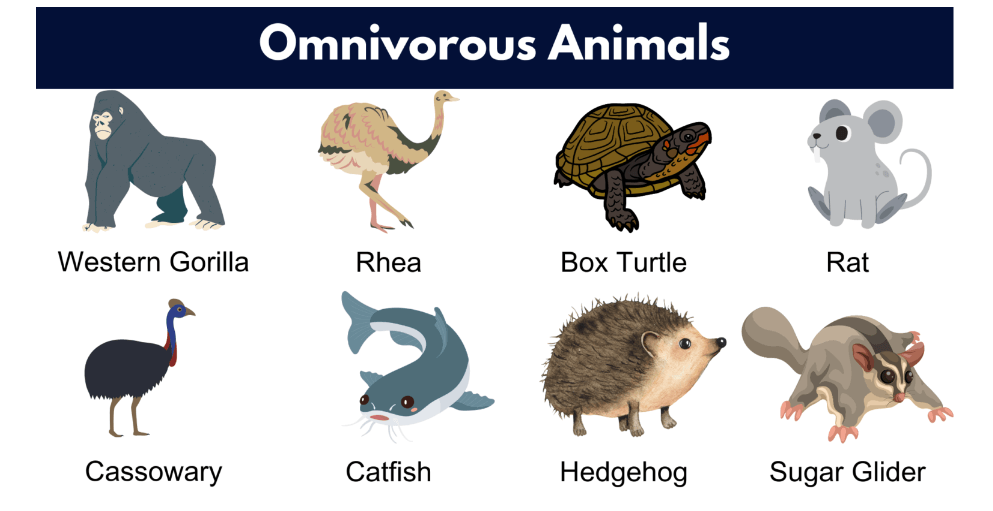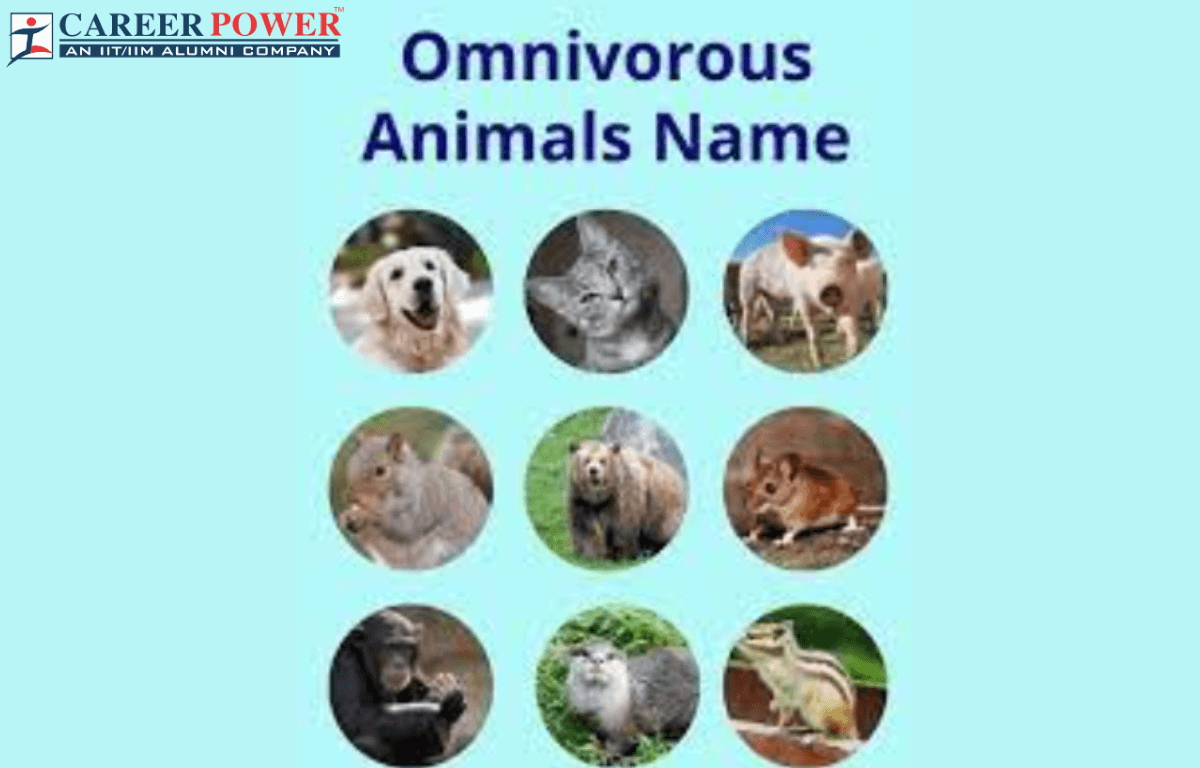As we all know animals are a very important part of biology. Animals can be categorized into three primary dietary groups based on their eating habits: Omnivores animals, Carnivores animals, and Herbivorous animals. Some animals specialize in their diets, while others may exhibit some flexibility and occasionally consume foods outside of their primary category. These dietary categories help describe the primary sources of nutrition for various animals in the animal kingdom.
What are Omnivore Animals?
Omnivore animals are popularly known as Omnivorous animals. Omnivores animals are organisms that possess a diverse diet, consuming both plant-based and animal-based foods to meet their nutritional needs. These animals have adaptability in their feeding habits, allowing them to consume a wide range of food sources, which can include fruits, vegetables, insects, small mammals, and more. This dietary flexibility helps them survive in various ecosystems and obtain essential nutrients from different food types. Examples of omnivorous animals include humans, bears, raccoons, and some species of birds like crows and seagulls.

Other Details About Omnivore Animals
Omnivorous animals eat both plants and meat. They have strong teeth for chewing plants and sharp teeth for tearing meat. Examples include humans, bears, and pigs. Omnivores can adapt to different foods, which helps them survive in various environments. Their diets give them a variety of nutrients, making them healthy and strong. Omnivore animals showcase the ability to thrive in a wide range of habitats and ecological niches due to their flexible dietary choices.
- Diverse Diet: Omnivores have evolved to exploit a wide variety of food sources, which provides them with greater adaptability and resilience in different environments.
- Teeth and Digestive System: Many omnivorous animals have a combination of teeth suitable for both grinding plant material and tearing flesh. Their digestive systems are often versatile and capable of processing both plant cellulose and animal proteins.
- Examples: Besides humans and the animals mentioned earlier, other examples of omnivores include pigs, dogs, foxes, and certain species of fish, such as tilapia.
- Ecological Role: Omnivores can play important roles in ecosystems as they can help control the populations of both plants and animals, making them important components of food webs.
- Behavioral Adaptations: Some omnivore animals have developed specific hunting or foraging behaviors to optimize their diet. For instance, raccoons use their dexterous paes to search for food in various environments.
- Health Benefits: Omnivores often have access to a broader spectrum of nutrients, which can be advantageous for their overall health and survival.
List of Some Omnivore Animals with their Description
The animals included in the omnivores category have diverse diets that include both plant matter and animal prey.
| List of Some Omnivore Animals | |
| Omnivore Animals | Description |
| Humans | Homo sapiens are the most common example of omnivores. They consume a wide variety of foods, including fruits, vegetables, grains, meats, and dairy products. |
| Bears | Bears are large mammals that have a diet consisting of both plant matter like berries and roots, as well as animal prey like fish and small mammals. |
| Raccoons | These small mammals are known for their adaptability. They eat fruits, nuts, insects, small animals, and even human garbage. |
| Pigs | Domestic pigs are omnivores and will eat a range of foods, including grains, vegetables, fruits, and occasionally small animals if available. |
| Foxes | Foxes are opportunistic feeders. They consume a mix of small mammals, birds, insects, fruits, and berries. |
| Hedgehogs | These small spiky mammals eat a varied diet, including insects, worms, slugs, fruits, and vegetation. |
| Crows | Crows are highly intelligent birds that consume a diverse diet, including insects, small animals, fruits, seeds, and even carrion. |
| Chickens | Domestic chickens are omnivores, and their diet includes grains, seeds, insects, worms, and even small reptiles or amphibians when available. |
| Opossums | These marsupials eat a wide range of foods, such as fruits, vegetables, insects, small animals, and carrion. |
| Skunks | Skunks are omnivorous and eat insects, small mammals, fruits, and vegetation. They are also known to scavenge for food. |
Some More Examples of Omnivore Animals
Now let us read some more examples of omnivore animals. These animals demonstrate the adaptability of omnivores, as they can obtain nutrients from both plant and animal sources.
| Examples of Omnivore Animals | ||
| Humans | Flamingos | Crayfish |
| Bears | Pandas | Red-winged blackbirds |
| Raccoons | Tarsiers | Turtles |
| Pigs | Koalas | Chickens |
| Crows | Armadillos | Anteaters |
| Chimpanzees | Bonobos | Mice |
| Foxes | Sun Bears | Frogs |
| Skunks | Baboons | Pigeons |
| Opossums | Manatees | Marmosets |
| Hedgehogs | Crab-eating Macaques | Turkeys |
| Seagulls | Toucans | Crabs |
| Squirrels | Kinkajous | Shrews |
| Prairie dogs | Fennec Fox | Starling |
| Iguanas | Walruses | Parrots |
| Hermit crabs | Rabbits | Worms |
Adaptation Of Omnivorous Animals
Omnivorous animals have unique adaptations that allow them to eat a varied diet of both plants and animals. These adaptations are both physical and behavioral, helping them survive in different environments. These adaptations make omnivores highly adaptable and able to thrive in many different environments. Here are some key features:
- Dentition:
Omnivores typically have a combination of sharp teeth for tearing meat and flat molars for grinding plant material. For example, humans have canines for meat and molars for plants.
- Digestive System:
Omnivores have a versatile digestive system capable of breaking down both animal proteins and plant fibers. Their stomachs are often more acidic than herbivores’ but less so than carnivores’.
- Behavioral Flexibility:
Omnivores are opportunistic feeders, which means they can switch their diet based on food availability. This behavioral flexibility helps them survive in diverse habitats and conditions.
- Senses:
Many omnivores have keen senses to help them locate a wide range of food sources. For instance, bears have an excellent sense of smell to find both plants and prey.
- Limbs and Claws:
They often have limbs and claws adapted for both catching prey and foraging for plants. Raccoons, for example, use their dexterous front paws to catch small animals and to manipulate food items.
- Dietary Variety:
Omnivores can eat a wide variety of foods, which helps them obtain all necessary nutrients. This varied diet can include fruits, vegetables, seeds, nuts, insects, and small animals.



 50 Vegetables Name for Kids in English a...
50 Vegetables Name for Kids in English a...
 Food Chain: Definition, Types, Examples,...
Food Chain: Definition, Types, Examples,...
 Human Respiratory System: Definition, Di...
Human Respiratory System: Definition, Di...













